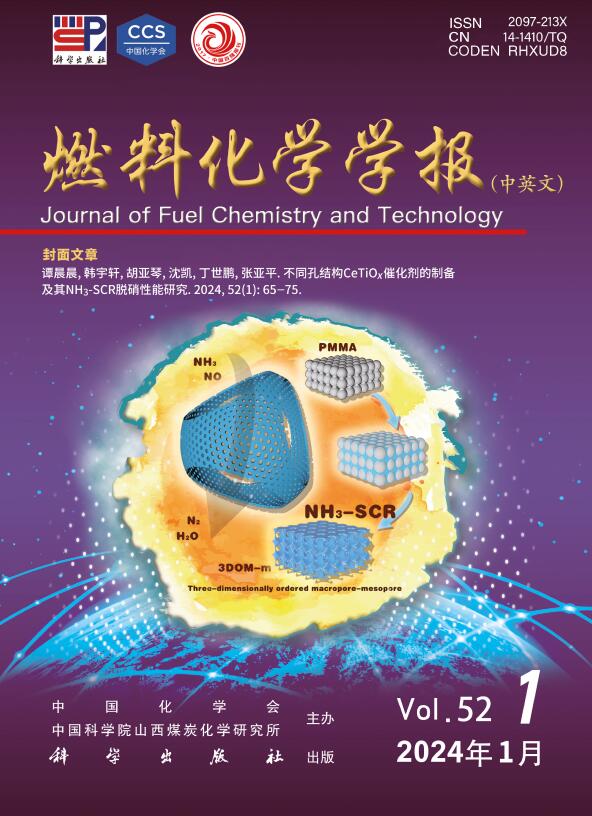通过过渡金属掺杂调整氧空位,实现高效析氧反应
Q3 Energy
引用次数: 0
摘要
本文制备了一系列可控Cr掺杂(0.5%,1%,3%)的Cr掺杂RuO2@NC催化剂(Cr0.1-RuO2@NC, Cr0.2-RuO2@NC, Cr0.4-RuO2@NC),研究了过渡金属掺杂与氧空位(OV)形成和出氧反应(OER)性能之间的机理相互作用。系统表征结果表明,随着Cr含量的增加,氧空位浓度呈火山型趋势,在Cr掺杂1%时达到峰值(Cr0.2-RuO2@NC)。x射线衍射(XRD)和x射线光电子能谱(XPS)分析证实,Cr掺杂有效地诱导了RuO2的电子结构重建,产生高密度的氧空位作为电化学活性位点。优化后的Cr0.2-RuO2@NC催化剂表现出优异的OER性能,在10 mA/cm2下实现了223 mV的低过电位,Tafel斜率为63.8 mV/dec,显著优于掺杂0.5%和3%的催化剂。值得注意的是,27 h后仍保持99.9%的初始活性。Cr掺杂不仅通过晶格畸变调节氧空位的浓度。强的Cr-O共价键增强了催化剂的结构稳定性。本研究为精确氧空位工程建立了一种通用的过渡金属掺杂策略,为开发高性能OER电催化剂提供了新的设计原则和理论基础。本文章由计算机程序翻译,如有差异,请以英文原文为准。
Tuning oxygen vacancy via transition metal doping for efficient oxygen evolution reaction
In this paper, a series of Cr-doped RuO2@NC catalysts (Cr0.1-RuO2@NC, Cr0.2-RuO2@NC, Cr0.4-RuO2@NC) with controlled Cr doping (0.5%, 1%, 3%) were prepared to investigate the mechanistic interplay between transition metal doping, oxygen vacancy (OV) formation and oxygen evolution reaction (OER) performance. Systematic characterization results reveal that the oxygen vacancy concentration follows a volcano-type trend with increasing Cr content, peaking at 1% Cr doping (Cr0.2-RuO2@NC). Combined X-ray diffraction (XRD) and X-ray photoelectron spectroscopy (XPS) analyses confirm that Cr doping effectively induces electronic structure reconstruction of RuO2, generating high-density oxygen vacancies that serve as electrochemically active sites. The optimized Cr0.2-RuO2@NC catalyst exhibits exceptional OER performance, achieving a low overpotential of 223 mV at 10 mA/cm2 and a Tafel slope of 63.8 mV/dec, significantly surpassing its 0.5% and 3% doped counterparts. Remarkably, it retains 99.9% of the initial activity after 27 h. Cr doping not only regulates the concentration of oxygen vacancies through lattice distortion. The strong Cr–O covalent bonding enhances the structural stability of the catalyst. This work establishes a general transition metal doping strategy for precise oxygen vacancy engineering, providing new design principles and theoretical foundations for developing high-performance OER electrocatalysts.
求助全文
通过发布文献求助,成功后即可免费获取论文全文。
去求助
来源期刊

燃料化学学报
Chemical Engineering-Chemical Engineering (all)
CiteScore
2.80
自引率
0.00%
发文量
5825
期刊介绍:
Journal of Fuel Chemistry and Technology (Ranliao Huaxue Xuebao) is a Chinese Academy of Sciences(CAS) journal started in 1956, sponsored by the Chinese Chemical Society and the Institute of Coal Chemistry, Chinese Academy of Sciences(CAS). The journal is published bimonthly by Science Press in China and widely distributed in about 20 countries. Journal of Fuel Chemistry and Technology publishes reports of both basic and applied research in the chemistry and chemical engineering of many energy sources, including that involved in the nature, processing and utilization of coal, petroleum, oil shale, natural gas, biomass and synfuels, as well as related subjects of increasing interest such as C1 chemistry, pollutions control and new catalytic materials. Types of publications include original research articles, short communications, research notes and reviews. Both domestic and international contributors are welcome. Manuscripts written in Chinese or English will be accepted. Additional English titles, abstracts and key words should be included in Chinese manuscripts. All manuscripts are subject to critical review by the editorial committee, which is composed of about 10 foreign and 50 Chinese experts in fuel science. Journal of Fuel Chemistry and Technology has been a source of primary research work in fuel chemistry as a Chinese core scientific periodical.
 求助内容:
求助内容: 应助结果提醒方式:
应助结果提醒方式:


